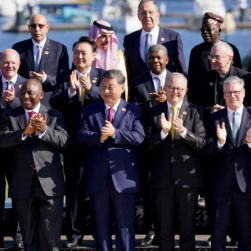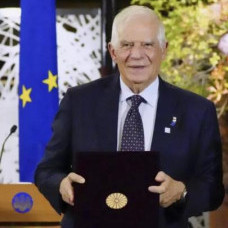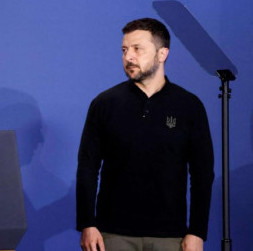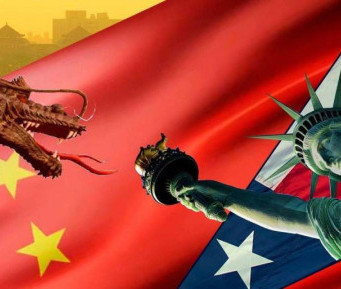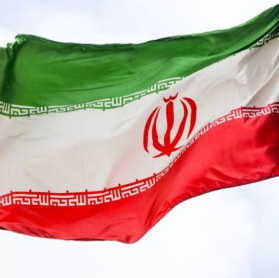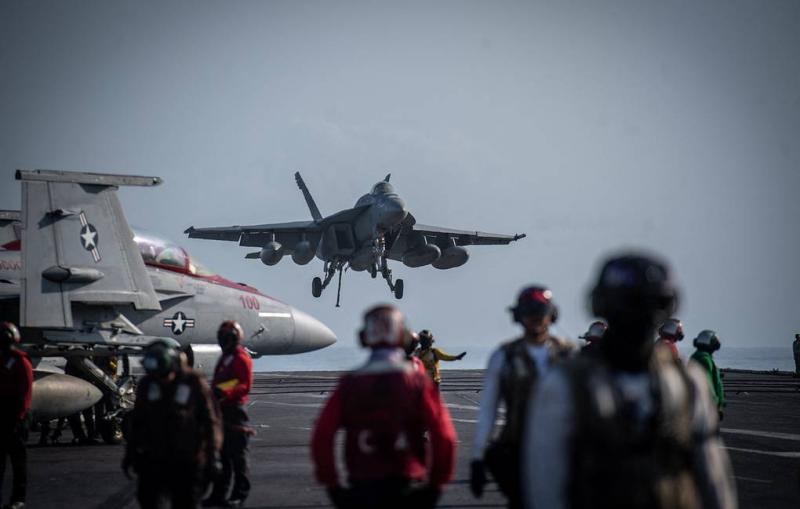
© U.S. Navy photo by Mass Communication Specialist 2nd Class Justin McTaggart via ABACAPRESS.COM/Reuters/TASS
Top stories from the Russian press on Wednesday, April 12th, prepared by TASS
The US and the Philippines are holding their largest joint exercise in 30 years in the wake of China’s recent drills around Taiwan; the chief designer of the Russian Orbital Station (ROS) weighs in on its prospects; and the IMF upgrades Russia’s growth forecast for 2023. These stories topped Wednesday’s newspaper headlines across Russia.
Vedomosti: US kicks off largest exercise with Philippines in 30 years
On Tuesday, the United States began the Balikatan exercise, its largest joint drills with the Philippines in the past 30 years. The exercise is seen as a response to China’s large-scale naval and aviation maneuvers around Taiwan on April 8-10. The joint US-Philippine exercise is being held against the backdrop of the confrontation between Washington and Beijing in the South China Sea. At a briefing on April 4, Chinese Foreign Ministry Spokesperson Mao Ning lamented that the increase in military deployments by the US "would only lead to more tensions and less peace and stability in the region."
The exercise will involve 12,200 US and 5,400 Philippine soldiers, as well as 111 servicemen from Australia. During the two weeks of the drills, the military personnel will practice amphibious, urban, aerial and counterterrorism operations, as well as live-fire training and maritime security procedures. The field exercise, which will test the allies’ capabilities, communication between units, logistics and information sharing, will take place across the Philippines. The exercise will bring Filipino and US troops together for live-fire drills at sea for the first time ever.
Vladimir Vasilyev, a senior research fellow at the Institute for US and Canadian Studies, sees the major maneuvers in the Philippines as a logical move by the US, as the Biden administration needs to show some muscle after its lackluster reaction to the recent Chinese balloon incident. In addition, against the backdrop of ongoing criticism from the Republican opposition, the administration needs to demonstrate continuing US fealty to the policy of containing China, the expert argues. Currently, the US is concerning itself with creating a geographical alliance around China’s east coast. Building such an anti-China arc would open up a new area in the US-China confrontation, and it appears that the Biden administration is planning to ramp this area of confrontation up even further, Vasilyev concluded.
Daria Panarina, a research fellow at the Russian Academy of Sciences’ Center for Southeast Asia, Australia and Oceania Studies, pointed out that the Philippines still has its own confrontation with China over certain islands and sea territories in the South China Sea. The island nation has been balancing between the US and China for years, but Washington has been its key partner historically, as the Philippines was a US colony until the mid-20th century, she said. Now, the Philippines has become a springboard for American interests in the region, and the US is using territorial disputes here as leverage in its policy of containment against China, the expert added.
Rossiyskaya Gazeta: Chief designer discusses project to build Russia’s new orbital station
Russia plans to launch the first module of its new orbital station in 2027, while the entire facility should become fully operational in 2032, Vladimir Kozhevnikov, chief designer of the Russian Orbital Station (ROS), said in an exclusive interview with Rossiyskaya Gazeta.
While the International Space Station (ISS) can remain functional until 2028, the ROS should be a successor to the Russian segment of the ISS, which is why it should be built before the Russian orbital segment expires, he explained. The new orbital station will enable preserving the unique competencies and personnel, as well as transitioning from the exploration of near-Earth space to its targeted use in practice, Kozhevnikov added. According to him, the ROS has been designed as a sphere with six ports, to which the other modules will be able to dock. As soon as the main one uses up its resources, it will be possible to undock and deorbit it so that a new one could be docked instead.
In addition, foreign spacecraft could dock with the ROS, given that their docking units match the parameters of the Russian units, which have been designed to an international standard. The new station will be able to accommodate and provide everything necessary for up to six cosmonauts, but Kozhevnikov’s team expects that the presence of more than two crew members would not be needed given the available level of automation.
When asked why it was necessary to launch a new station if a hundred satellites are currently available for remote sensing of the Earth, Kozhevnikov said that the ROS would be cheaper and it would enable people to conduct medical and biological research, and test equipment for experimental production, as well as telescopes, various radars and Earth scanning devices, tasks which he said robots cannot currently perform without humans.
Also, the new station should help develop the technology of deeper space flights, the chief designer said. Assembling interplanetary expedition complexes on board the ROS, including for flights to the Moon, is currently being considered. In general, the station should become a testing ground for all things new in space in near-Earth orbit, he concluded.
Vedomosti: IMF upgrades its Russian economic forecast for 2023
This year, Russia’s GDP will see 0.7% growth, according to the International Monetary Fund’s April forecast. Back in January, the IMF’s figure for Russia was 0.4 percentage points lower. Looking ahead at next year, however, the IMF sees falling energy prices dampening Russian economic growth in 2024, when Russia’s GDP is expected to rise by 1.3%, or 0.8 percentage points lower than the IMF’s January forecast figure.
In 2022, Russia earned the bulk of its revenues from energy exports amid high energy prices, and those will still play a role, but the effect will be lower in 2023 and 2024, IMF Economic Counsellor and Research Director Pierre-Olivier Gourinchas explained.
The IMF is likely more upbeat about Russia because Rosstat figures showed GDP growth for two consecutive quarters, and the trend may continue in the coming months, economist Viktor Tunev told Vedomosti. Export restrictions are no longer affecting growth, and Russia may see higher domestic demand in the absence of new shocks, he added. According to Tunev, businesses and individuals have accumulated significant excess savings, as well.
In 2023, consumption should prop up economic recovery, economist Alexander Isakov believes. According to him, wage growth in excess of inflation and an increase in retail lending should drive economic growth. He doubted that the IMF fully took the continued decline in oil production into account, though. To Isakov, a global recession may pose major risks to the economy: oil prices could drop, which would destabilize Russia’s currency market and inflation. Also, a labor shortage is already giving rise to lower profitability in some non-commodity industries as well as a loss of competitiveness against imports, the expert cautioned.
Izvestia: How will Shiveluch eruption affect global warming?
The Shiveluch volcano on Russia’s Kamchatka Peninsula may remain active for a few more days, but no major eruptions should be expected, experts interviewed by Izvestia said. The volcanic ash fall was the heaviest seen in the past 60 years, sending an ash cloud over an area of about 500 km, the Emergencies Ministry said. The natural emission may give rise to bronchopulmonary diseases in the region, doctors warn. Meanwhile, climate experts say global warning may now slow down as the ash fall in the stratosphere will serve to lower average temperatures on the planet slightly.
Alexey Sobisevich, who heads a laboratory at the Institute of Physics of the Earth of the Russian Academy of Sciences, told Izvestia that Shiveluch would soon exhaust its eruption potential and there could only be minor eruptions in the next few days.
In the longer term, Shiveluch eruptions may cause slight changes in the average temperatures on the planet, climate experts warn. One of them, Alexey Kokorin, said products from volcanic eruptions stay in the atmosphere if the ash cloud rises 10 to 15 km high, while this time the ash reached a height of 20 km, which may cause global cooling. The pace of global warming will be lower if volcanos erupt more actively, the expert said. Temperatures will spike as soon as any eruptions cease, Kokorin forecasts.
Izvestia: Bitcoin could rise to $40,000-50,000 if Fed sticks to current rate path
Bitcoin could reach $40,000-50,000 this year if US inflation falls, and the Federal Reserve stays the course on rates, experts interviewed by Izvestia said. On Tuesday, the world’s largest cryptocurrency breached the $30,000 level amid worries about the lingering banking crisis in the United States and rising risk appetite.
Investors have been using cryptocurrencies to diversify their assets and lower risks amid a looming global crisis, analyst Sergey Ramaninov said. Moreover, Beijing and Hong Kong have signaled their support for crypto, which may send digital currencies even higher, the expert said.
Investors expect the Fed to refrain from raising rates at the next FOMC meeting, and the US central bank may even embark on a path toward easing, Leonid Kornilov, Finbridge Board Chairman, emphasized.
The majority of experts expect bitcoin prices to rise, with Ethereum reaching $2,500-3,000 by the year-end. Ramaninov estimates that US inflation will peak in 2023, while the Fed has repeatedly signaled it will stop tightening by December, which should spur stock prices and cryptocurrencies, the expert concluded.
